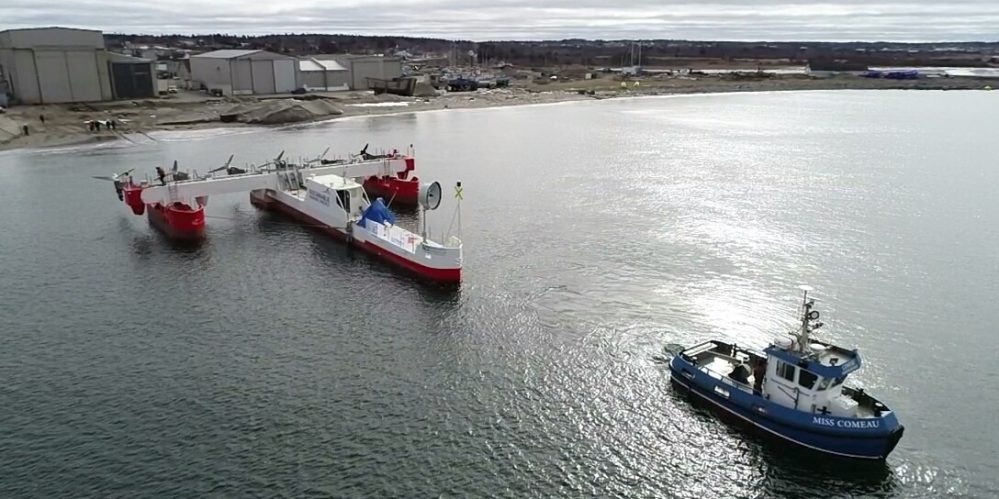
- Sustainable Marine unveils “next-gen platform” in Nova Scotia ahead of tidal energy project.
- The University of Arkansas will build a new solar lab to teach accredited solar technicians.
- UnderstandSolar is a free service that links you to top-rated solar installers in your region for personalized solar estimates. Tesla now offers price matching, so it’s important to shop for the best quotes. Click here to learn more and get your quotes. — *ad.
Floating tidal energy array
Edinburgh-headquartered Sustainable Marine, which provides island and remote coastal communities with sustainable energy, is moving ahead with plans to deliver the world’s first floating tidal energy array after unveiling its next-generation platform in Nova Scotia.

Construction of the new 420kW PLAT-I 6.40 floating tidal energy platform was recently completed at AF Theriault & Son Ltd. in Meteghan, Nova Scotia, and launched yesterday in the Bay of Fundy, which experiences the highest tides on earth.
Here’s how it works, according to Construction Connect:
The PLAT-I 6.40 will host six tidal turbines that have been designed to flip up like an outboard motor on a powerboat for easy maintenance. The platforms will be anchored to bedrock using a four-point mooring system… and will be able to spin around the mooring turret… to align with both the advancing and receding tide each day. Onboard generators will match the power up to the grid frequency and the power will be exported via underwater cable to the shore.
It will undergo commissioning and testing in Grand Passage, a river in Nova Scotia, and will then be moved to the Fundy Ocean Research Centre for Energy site as part of the first phase of the groundbreaking Pempa’q In-stream Tidal Energy Project. The Pempa’q Project takes its name from the Mi’kmaq First Nation word “Pempa’q” meaning “rise of the tide.”
The total in-stream tidal energy project will deliver up to 9 megawatts of electricity to the Nova Scotia grid. This will reduce greenhouse gas emissions by 17,000 tonnes of carbon dioxide a year and power approximately 3,000 homes in Nova Scotia. It’s being supported by the Government of Canada with CAD $28.5 million (USD $22.2 million) in funding – one of Canada’s largest-ever investments in tidal energy.
Seamus O’Regan, Jr, Canada’s minister of natural resources, said:
We are harnessing the power of our tides to power our homes, our businesses, and our communities. This is how we build our clean energy future.
University of Arkansas solar program
The University of Arkansas Hope-Texarkana (UAHT) is building an education lab at its Hope campus in order to deliver a new Certificate of Proficiency in Solar Energy Technology program.
Laura Clark, interim chancellor, said:
The lab will be modeled after the state-of-the-art Solar Energy International (SEI) lab in Colorado and will allow our students to take their classroom instruction and apply it by actually installing and uninstalling several types of solar arrays. The lab will be the first of its kind for photovoltaics in the region and fills a current need for accredited technicians in Arkansas.
Using the SEI curriculum, UAHT will become an approved training provider for the North American Board of Certified Energy Practitioners (NABCEP). This certificate provides the necessary training to install, construct, maintain, and operate solar electric systems. The classroom curriculum for the program is expected to begin in the fall 2021 semester. The certificate is part of the path to completing the Associate of Applied Science in Power Technology degree at UAHT.
Clark continued:
Becoming an approved NABCEP training partner means our graduates are eligible to sit for the NABCEP PV Installation Professional Certification Exam to earn their PV Associate Credential.
The PV Associate Credential is the opening pathway for graduates who want to move into specializations such as design, inspection, or solar fields engineering. The credential also opens the door for UAHT to add these additional educational tracks for credit and non-credit certifications.
Industry expansion is expected in Arkansas, Louisiana, and Texas, which will create new renewable energy jobs. The solar lab will give our students a real hands-on learning experience that will allow them to be competitive in this growing job market.
The university is also installing a 1 MW solar project that will take sit on around seven acres on the south end of the campus and provide electricity for the university.
According to Solar Industry International Association, Arkansas moved from 36th in 2019 to 25th in 2021 in the US for solar installations. There are currently 26 solar companies in the state.
Subscribe to Electrek on YouTube for exclusive videos and subscribe to the podcast.
Author: Michelle Lewis
Source: Electrek



